#language changes
Explore tagged Tumblr posts
Text
D'you reckon the fae would be unstoppable if they found out the thing that mums do to get you to do things. Like I'll be sitting on the couch and the dishes aren't done, then my mum comes and says "thanks for doing the dishes" the I go do the dishes. Like if they acknowledge a debt for something that hasn't happened yet, technically aren't you in their debt BC you haven't performed the service you have been explicitly thanked for? Idk if this makes sense but ye
8 notes
·
View notes
Text
You know what I can’t stand? The “bi only means two” people!! Who apparently I’m just finding out my fiancé is!! I mean, it’s not a deal breaker cause he has so many good qualities, but cmon!! Bisexuality for such a long time has meant loving two or more genders, and he has the gall to come in here like “I’m bisexual but I also love nonbinary people.” I mean, being a stickler for language is one thing, but you also should keep track of how language changes!! That’s what language does, and that’s what it was always meant to do!! It just felt sorta weird when he was trying to explain how he felt about his identity to me, and then he dropped that in there. It felt like “ I see bisexual as meaning only 2, but you get your own special category over here.”
#bisexual pride#bisexuality#bisexual#bisexual positivity#bisexual has always meant loving two or more genders#bi positivity#bi pride#bi umbrella#language#language change#language changes#language always changes#nonbinary#trans masc#trans masculine#trans man#trans man positivity#trans community#ftm trans#trans pride#transmasc#gay transmasc#gay trans guy#gay trans man#annoyed#angry#im upset#conflicted#bi doesn’t only mean 2
4 notes
·
View notes
Text

Isogender Is not trans in denial!! Someone may be an identity that still aligns heavily with their agab! So they don't feel like part of the trans community! But they don't have to identify as cis because their identity isn't fully the same as their agab.
My sister is enby. They are afab and use they/she pronouns. As you can tell, they are still heavily fem-aligned. They feel that them being enby doesn't take away their identity as an afab but also doesn't make them a woman. They don't use this label but that's an example of why someone might.
There are lots of labels for systems who have strange experiences with being trans! This is a label some of our transfem alters are interested in. We are afab and masc-transitioning enby. So our body will not be cis to them ever either. But they were still formed in an afab body so using trans doesn't feel quite right to them. Boom! (used for reference: instagram account nocontext_inclus and lgbt-pride.fandom.com ).
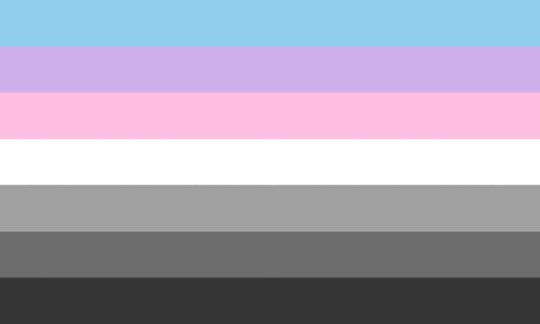
I believe this flag was coined by @beyond-mogai-pride-flags and from top to bottom, the colours represent; masc, fem, mix of both, and the gradient represents a strong-to-weak attachment to gender, from top to bottom. (Source: lgbtqia.wiki and mogai.miraheze.org ).

#neutralist and exclusivist iwc#inclus safe#mogai friendly#pro bi lesbian#isogender#my experiences#sysblr#no discourse#friendly#anti endo#the ever fluctuating experiences of gender are not comparable to medical conditions#trans system#please be nice#i'm sensitive#gender fuckery#take no shit#language changes#where my linguists at#words words words#inclus system#system#did system#did osdd#moots pls#under 17 pls dni#you can look at my acct but moots must be 17-24#meow#actually adhd#meowmeow#discord user spotted
35 notes
·
View notes
Text
Saying “people with uteruses” is NOT erasing women any more than saying “all humans are created equal” is erasing men.
#language changes#to be more inclusive#of people who were historically excluded#it’s not the end of the world#trans#trans rights#trans rights are human rights#no lgb without the t#lgbt#lgbtq#lgbtqia#lgbtqiia+#queer#gender is a social construct
18 notes
·
View notes
Text
today’s “pathetic sopping wet cat of a man” is yesterday’s “smol bean, cinnamon roll too pure for this world”
1 note
·
View note
Text
every new person who found this and is reblogging it with ‘tw slur’ or ‘f slur’ is getting blocked. you don’t get to censor my identity, my identity is not a slur.
not femininity or masculinity but a secret third thing (faggotry)
9K notes
·
View notes
Text
Millennials keep hating on "skibidi" like we didn't run around saying "skadoosh" and "badum-psh" or a billion other wicka-wicka-wicka sounds—we just didn't write them out because we didn't have to communicate via text to have friends, leave the children alone. 😭
#language changes#slang#linguistics#leave them alone#technology#text vs speech#skadoosh#wicka wicka wicka slim shady#we read it in the lyric booklets though#skipidi doo da
1 note
·
View note
Text
Studying linguistics is actually so wonderful because when you explain youth slang to older professors, instead of complaining about how "your generation can't speak right/ you're butchering the language" they light up and go “really? That’s so wonderful! What an innovative construction! Isn't language wonderful?"
#linguistics#gen z slang#english#as people in the reblog pointed out!#most gen z slang comes from (or was appropriated from) aave#honestly I was just excited to talk about how people in my field actually get excited about non standard uses of English#instead of ridiculing speakers#and I tagged incorrectly and didn’t point out the very real issues of language and power and appropriation inherent in modern slang#in that much of it was appropriated#and even that which experiences language change in the wider culture still originated in aave#aave is just as linguistically valid as any other English dialect because it is a proper language#and the grammar is incredible!!!#habitual be is fantastic and an excellent example of how a richer case system or a certain case can render an adverb unnecessary#and the phonology is just beautiful#anyway I’m very sorry#I fucked up
29K notes
·
View notes
Text
We're not appreciating the Weird Barbie enough. It's said in the movie that she helps everyone who need help while they always see her as someone who's not as good as them. She was friends with all dismissed Barbies and Kens, was there to offer support and safe shelter for everyone who needed it in Kendom, without her nothing in the movie would've been alright. When Stereotypical Barbie calls her "ugly and unwanted" she still helps her.
She was representing a woman in women's world who was pushed aside by other women because she didn't fit in but still had more wisdom and kindness than everyone who thought they're better than her.
#weird barbie#barbie#Barbie movie#everyone looks at her as a queer person i see her as me I'm a straight person who got bullied simply for being different than the rest#but it's beautiful that we all see ourselves in her whatever our story is#cuz that's the point of characters like her#i changed wisness to wisdom sorry english isn't my first language and i forgot which one is more correct
47K notes
·
View notes
Note
Starting the queer history in 2005 is also a sweet summer child sorta thing.
I'm not going to get into the relationship between gay culture and older Who because I am in no way an expert and don't want to do misinformation.
What I can do is offer my lived recollections of a period I don't count as Old Who.
In 1996, Doctor Who briefly came back in a story where he kissed a woman.
There was backlash about this.
Half of it, the most publicised in newspapers half, was from the right wing puritan "everyone in fiction should be asexual but not in the good way" crowd. They were a dominant force in the UK in the 80s/90s. They didn't want the Doctor kissing anyone. For purity reasons.
The other half was people who didn't want the Doctor kissing a woman.
Because he should be kissing men.
Because Doctor Who was, even at that point, a Gay Nerd Culture Thing.
RTD didn't make Doctor Who gay. He is a gay British nerd of a certain age. Therefore, he was into Doctor Who. For gay reasons. Statistically speaking, if Doctor Who was going to come back, it was going to be brought back by gay people, because they were the champions of the show.
Because it was already gay, before 1996.
how is Doctor Who landmark queer sci-fi?
I don't think the 2005 showrunner, first and foremost a very prevalent author of queer fiction, can or should be disentangled from the show, both literally and thematically, and I don't think it can really be understated how groundbreaking it was for pg rated sci fi (or really any sci fi) in the year 2005 to have a recurring character in a heroic bisexual man who the doctor openly flirts with and kisses in a dramatic context, much less that this character heads a major spin off aimed at a queer audience. among other things.
slight tangent but honestly I feel like queer discourse can be a bit dismissive of this sort of stuff, art that they don't find to be notably gay by 2025 standards, or which comes from a queer perspective but in which queerness isn't baked into the literal premise, works that are metaphorical; these often get dismissed as less good or less important or less gay somehow and I think that's a really limiting way of looking at queer art. Stuff like doctor who, in my opinion, should be looked at in much the same way we'd consider davies' other works, rather than only notable when the lead specifically is explicitly characterized as queer (as he is currently, 20 years down the line)
#please also note that when I say gay culture#I'm referring to what would today be called queer culture#language changes#that's how most people would have referred to it at the time
330 notes
·
View notes
Text



Bluest hour.
Originally a bw lighting study but i played around and found blue prettier. Anyway here’s the bw version because i like it too.

#myart#jjba#leone abbacchio#i was watching jjba dub in my native language the other night and i miss my goth husband#vento aureo#yes my art style changed👉👈
3K notes
·
View notes
Text
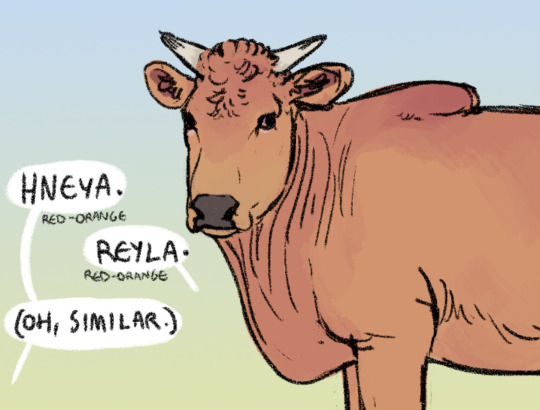

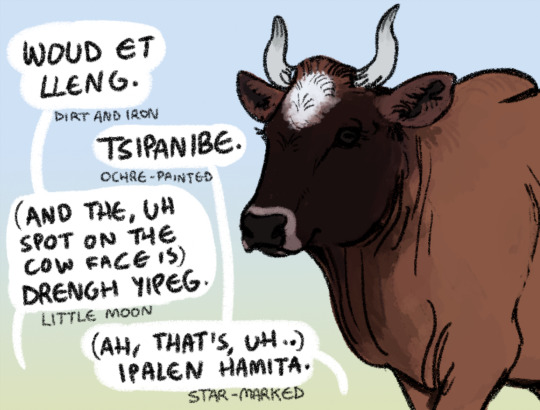
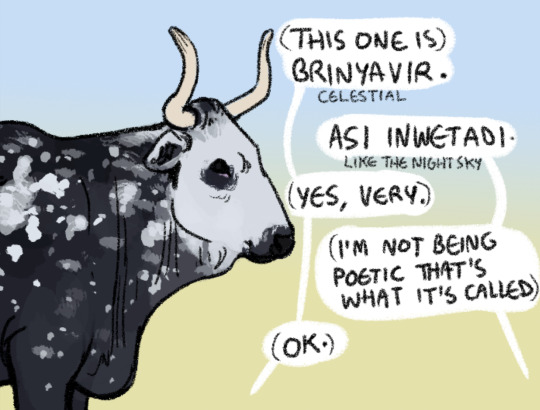
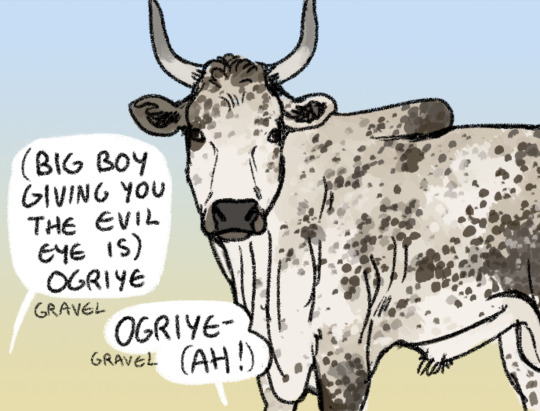
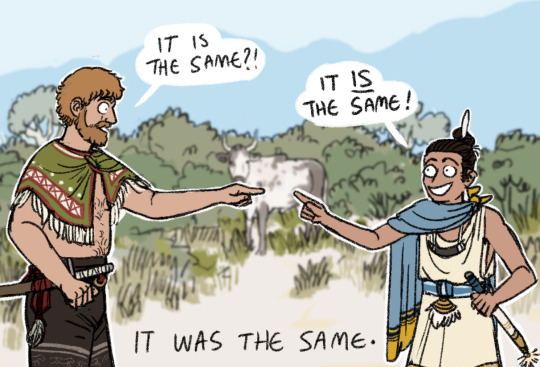
Comparing livestock color-words.
Both the Chenahyeigi and Wardi languages are derived from peoples who have been pastoralists for millennia, and both have an absolute ton of words for livestock coloration.
Both languages have had at least some mutual influence for about a thousand years (to varying extents by dialect, depending on geography/trade connection) so you'll see similar or identical words crop up here and there.
THE WORDS:
Hneya - [hne:ʝɑ] or [hne:jɑ] (whether the ʝ sound is retained in speech and to what extent varies by dialect)
Straightforwardly refers to bright reddish-orange color, but is mostly used for animals rather than other orangeish things. The word Was probably influenced by an older form of the Wardi 'reyla', and absorbed with the introduction of orange colored cattle. It may have been merged with the Chenahyeigi '(h)ne', which is the root of several red color-related terms.
Reyla - [rejlɑ]
This is a Wardi word for most reddish-orange hues in general. When applied to livestock, it refers to solid orange coats without spotting/masks/notable countershading.
Fels akhri - [fels] [ɑ:khɾi]
Translates readily as 'storm cloud' (the 'storm' here specifies thunderstorms). When applied to livestock, it describes fur that is rich dark blue-gray with white guard hairs.
Aganne - [ɑgɑ:ne]
This doesn't actually translate to 'night sea' in a straightforward manner, but as a color word it's poetically associated with dark seas, at night or in storms. When used for livestock, it describes this coloration exclusively.
Woud et lleng - [woʊd] [ɛt] [ɬeŋk]
Woud is the word for rich moist soil specifically, lleng refers to laterite and its association with iron deposits. This phrase is used to describe livestock with dark brown heads and and orange-brown bodies.
Tsipanibe - [t͡sipɑnibe]
This would be more literally translated as 'ochred'. Many Wardi words with the -ibe stem from verbs or nouns modified to indicate that the subject matter has 'received' an action or concept. (Examples of such words are long-established linguistically, you can't just add '-ibe' to any noun or verb). This one takes the root 'tsipan' (ochre) and applies it to the subject matter (cattle coloration).
Livestock with a dark brown or black head and orange-brown body are given this description, the idea being that their bodies look like they've been painted in ochre. This word is extremely rare outside of this context (you would usually just say the full 'ochre-painted' to convey this idea for other things)
Drengh yipeg - [dɾeŋg(h) yɪpɛ:g]
This is pretty straightforwardly 'little moon'. Yipeg comes from the same root as the Wardi 'hippe' for 'small', while drengh refers to the appearance of the moons in the sky (rather than the gods they embody). It's used to describe small round white blaze marks.
Ipalen hamita - [ipɑlɛn (h)ɑmitə]
Straightforwardly 'star marked', used for small round white blaze marks. Wardi actually does have a 'moon marked' (ipalen amit) to describe round white blazes that entirely cover the animal's forehead.
Brinyavir - [bɾi:nʝɑvir] (ʝ is retained for this word in most dialects)
This one is not directly translatable, 'celestial' or 'heavenly' just function closely enough. The word conceptually relates to stars but most specifically describes a layer of sky in which the afterlife rests (brinyavir is part of the phrase I translate as 'celestial fields'). The cattle there are said to have these markings. The stars in the night sky are sometimes playfully described as the spots of these cattle (though not literally, in Chenahyeigi cosmology stars are spirit-inhabited bonfires lit along pathways through the heavens).
As a color word for livestock, brinyavir refers to this rare (I Think nonexistent irl) white-spotted black coloration, due to both resembling the stars and the cattle that are moved among them.
Asi inwetadi - [ɑsi in:wetɑ:di]
This directly means 'like night sky', and is applied to this coat pattern with a similar underlying logic- it looks like a starry night sky. You will often see asi (like/akin to) retained in place or animal names like this, and it is sometimes part of names for people (the name Asinya is derived from a contracted 'like the sun').
Ogriye - Chenahyeigi: [oʊ:gɾije] Wardi: [oʊgɾi:je]
This word is (or was) a way to say 'gravel' or 'gravelly' in both Chenahyeigi and Wardi, and is pronounced very similarly in both (with the only significant difference being emphasis)
In Chenahyeigi it is a loanword from the Wardi language family, most likely received in the exchange of cattle of this coloration. It is retained in general speech as a word for gravel, more specifically the adjective 'gravelly'.
The word is mostly obsolete in contemporary Wardi, speakers do not know it used to mean 'gravel' (though it sounds close enough to assume a connection, the word is 'ogri') and exclusively use it to describe this livestock coloration (one of the more common among Wardi native cattle).
---
Also here's some cow lore.
There's some fairly tremendous diversity in Wardi cattle herds, given they have genetic influence from at least two separate aurochs domestication events (also distant and negligibly minor influence from one instance of bison domestication) and from multiple relatively isolated domestic cattle populations. Present day herds within Wardi provincial territory near-ubiquitously have at least some ancestry from the kulustaig and the Burri tepang cattle.
The ancestors of the Wardi native cow have been in the region for at Least 5,000 years. Burri cattle Possibly could have had tiny, isolated introductions between 2500-3000 years ago (this is extremely unlikely, but maize Was probably introduced by seafaring proto-Burri peoples at this time) or at more recent points since, and the tepang was certainly introduced during Imperial Burri occupation. High quality cattle are also occasionally received in diplomacy with the present-day Different Entity that is the Burri Republic. The kulustaig cattle arrived with proto-Finnic migrants starting 1500 years ago, and is the biggest external genetic influence on Wardi herds. Small populations of Yuroma native cattle arrived with migrants 540 years ago, though these have been wholly absorbed into Wardi herds, with their biggest trace being genes for naturally polled horns. Some Finn cattle were extracted in the recent two decades of Wardi occupation, though not enough to have a noteworthy genetic impact on any herds.
Most of the cattle in this post show predominantly Wardi native cattle + kulustaig ancestry (this takes place in the Ephenni riverlands, where the ancestry of herds tends to be around 2:1). The one with the blaze has a delicate sloping muzzle that suggests Burri tepang ancestry, and also likely has a wild aurochs grandparent (the white ring around the nose is a telltale sign, as it usually vanishes within a few generations of introgression).
Diversity in color and coat pattern is culturally favored for Wardi cattle herds, and selective breeding for aesthetics is usually limited to the purpose of preserving unique coats. The average herd tends to be very colorful, though the one shown here is a bit of an outlier, the universe having mysteriously put in place perfect conditions to compare the words for a variety of coat patterns.
#My marginal comprehension of the IPA has advanced somewhat. For those who don't know : indicates the vowel/consonant beforehand#is long and () means a sound is marginal/optional/not articulated#The 'h's you see at the end of a lot of Chenahyeigi words are usually soft unvoiced exhalations and very subtle#It's part of the accent but not doing it doesn't change the meaning of the word in most cases#The Wardi language has a tendency of dropping H sounds at the beginnings of words over time/in certain dialects#(especially when followed by the [i] vowel. A lot of people pronounce hippegalga as just ippegalga) and in a lot of words#pronunciation of leading H's is essentially optional#One aspect of Wardi formal register is always enunciating these droppable H's
2K notes
·
View notes
Text
I want to post this here too because I’ve seen it happen a few times
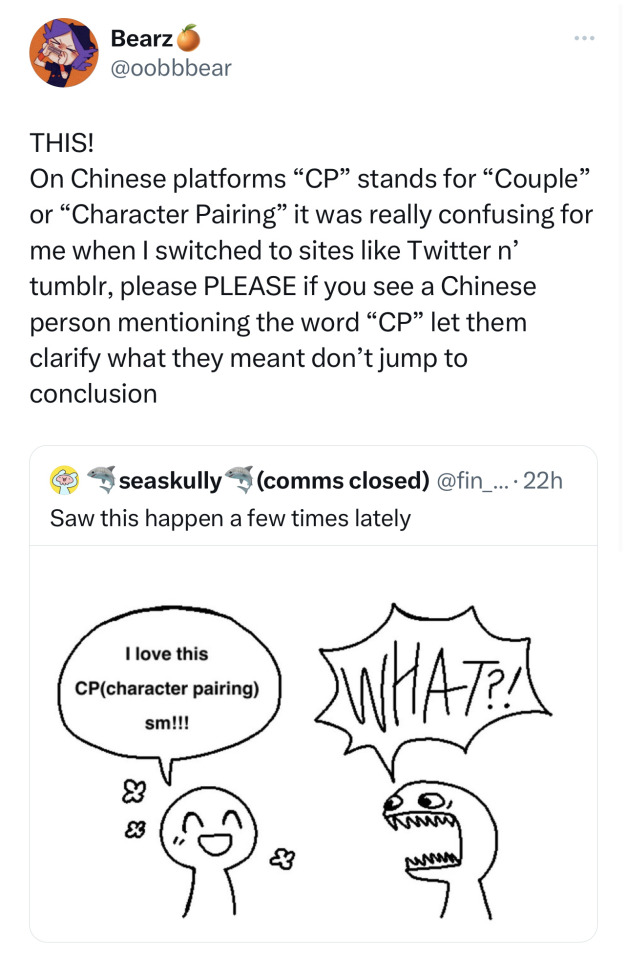
Please understand that there are cultural differences and language differences, if you see this happening let the person clarify what they meant, that person might just not be familiar with words the western side of the internet use
#bearz rambling tag#no it’s not really possible to let everyone who uses this term to change#because as far as I know this is the most common word with use on Chinese websites#I didn’t know that pairing are called ‘ship’ here#like why would I even know that#‘ship’ makes zero sense to me#it took me a while to learn the fandom language people speak here#it’s hard#give people time#shipping culture is very different too#Like on Chinese site you HAVE to clarify the Top and the Bottom of this ship in the ship name#it is very very important to them#people who like the same ship but with different Top Bottom preference will fight till no end#imagine how confused I was when I first got here#where there’s no top bottom differences#it’s not really a smut thing#it’s more a dynamic thing#AxB and BxA is very different#oh I can talk so much about the differences on fandom cultures#if ya are interested in more please feel free to ask#it’s very interesting to me#I wanna talk about it
10K notes
·
View notes
Text

#don't take that too seriously#i know some genders amd sexualities aren't really talk much about either#but it doesn't change that ace and aro are really too often forgotten#and when they are talk about its really either black or white when both ace and aro are spectrum and are really complexe#and i rarely see them well represented during pride month#pride month#asexual#aromantic#sorry for my bad English dogs it's not my first language o7
4K notes
·
View notes
Text
you know what fuck it, I love you historical spelling. I love you weird fossilised preservations of obsolete alphabets, grasping for something that exists now like mist, like liquid, its true pronunciation lost to time but not quite forgotten, not yet. a ghost remains, a friendly one, comfortable in this old house. I love you repurposed letters for phonemes that neither the old language nor the variety they were borrowed into has any need for anymore. I love you sensible vowel pairings that have grown - improbably - centuries later, into unwieldy diphthongs, quietly thriving in an ever-shifting environment like weeds nestled cosily beneath the shade of grander plants that have long since turned to mulch. I love the word 'diphthong' (the little thicket of consonants in the middle of it, sprouting up from nowhere to trouble tongue and penmanship alike). I love how Phoenician fingerprints remain in a Norman revision of an Anglo-Saxon reworking of a Roman borrowing of a Greek repurposing, all these shapes and signs moulded again and again like clay, like mud, spun like flax to carry all those lovely glides and nasals and obstruents which come and go and come and go over time as the sounds mutate and grow apart, and the people grow and age and die, leaving behind nothing except (sometimes) a page. a poem. a piece of themselves, their voice, rendered in imperfect beautiful scratchings whose contours match the ceaseless flow of time, heavy with all that history and somehow also light with the sheer urgency of being written. look at it, isn't it wonderful? this moment in time that holds within it yet other moments? other echoes calling down through the centuries? this is how we spoke, this is what we sounded like, once. this is how we thought our ancestors would have said it. I love the inconvenience. English is so hard to learn. the spelling is so illogical. so cumbersome. it's frustrating. it makes no sense. it's inconvenient. yes and yes and yes, and yet you too are inconvenient, you too are inchoate and too much and you fail to resolve into a neat and comprehensible order. but look at you. how lovely you are. I treasure you. why should the words you speak be any less lovely.
#historical spelling#English#prose poem#having a normal one#but unironically#language change#linguistics#too gay for words#pun intended
1K notes
·
View notes
Text
someone's probably pointed this out cause i'm not browsing tags but

Caleb's flower is hydrangea.
Not only a flower that changes colour in differing soil (Caleb is a chameleon or changes who is is depending on the person he's talking to or where he is?)
But the meanings are;
One sided/obsessive love, heartlessness, frigidity/coldness, apology, family and gratitude.
#wonder babbles#love and deepspace#caleb lnds#caleb#lads caleb#tumblr pls don't post stuff twice#i get easily confused#you wondered why cat curse mc learned flower language? (you probably didn't) the reason is cause i wanted to impress my friend#a long time ago and i ended up reading up so much about it#i am now a changed person and can only think about flowers with their meanings
1K notes
·
View notes